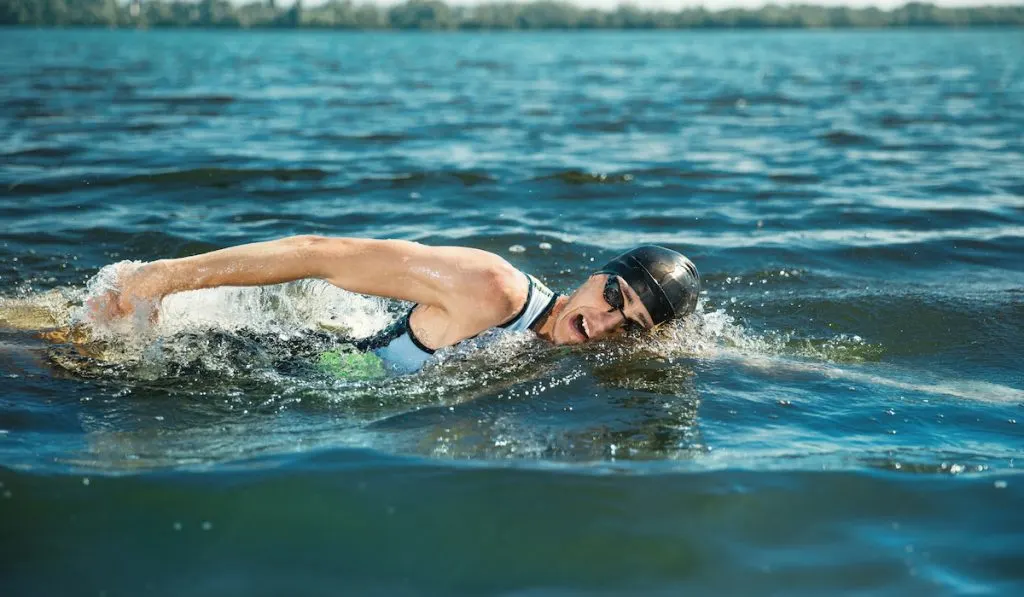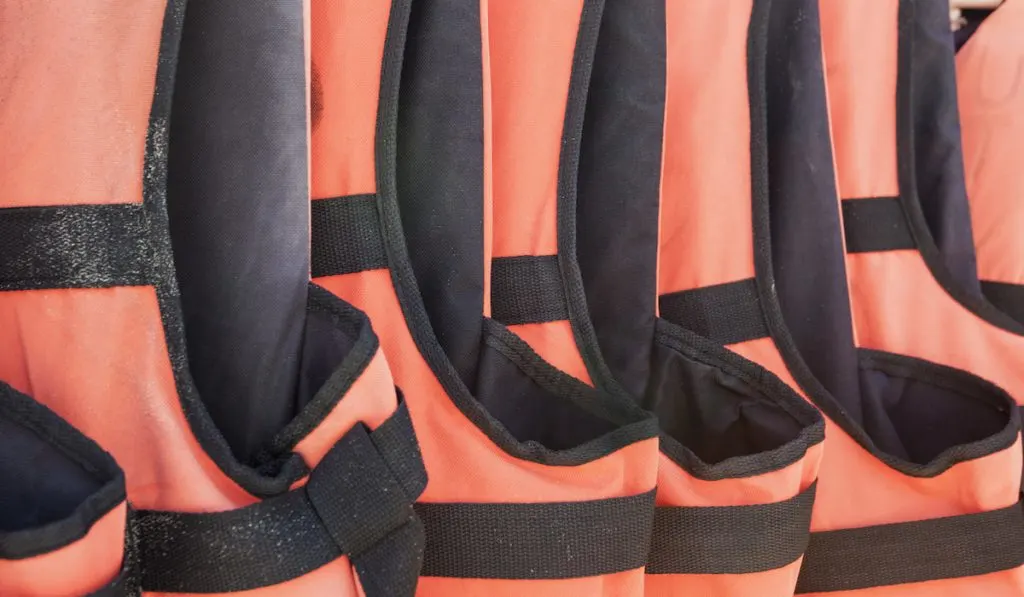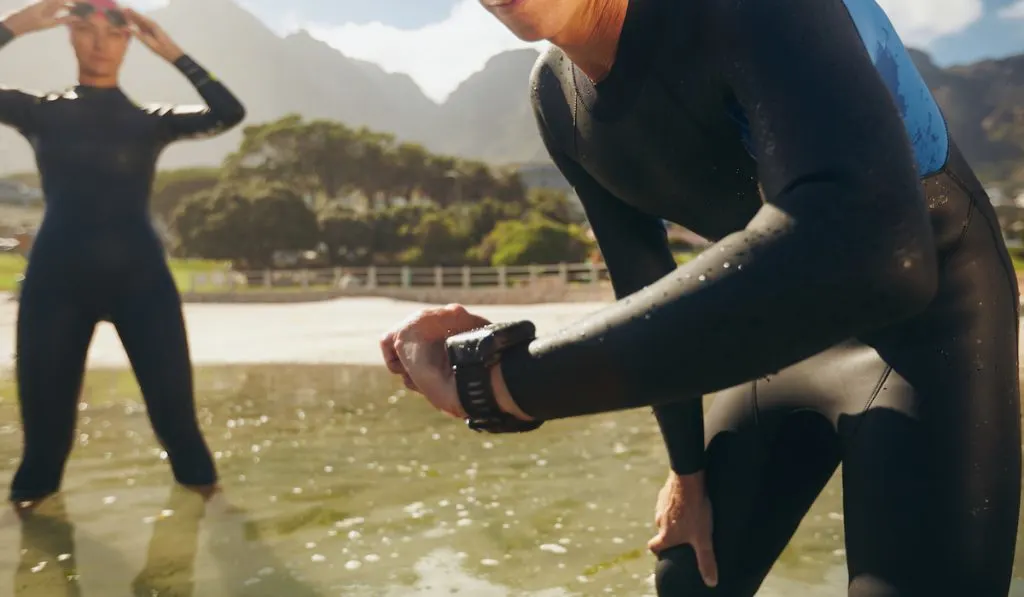The swim portion of the triathlon can be daunting for a lot of athletes. Even if you’re a seasoned swimmer, participating in the open water swim of many triathlon events is intimidating.
There’s the adrenaline rush at the start of the event, and you’re swimming fast in a sea of other swimming. There’s a lot of thrashing and you’re likely to knock into a person or two until the crowd thins out.
Concerns over swimming make some people, understandably, nervous about staying afloat. Most events go to great lengths to keep swimmers safe.
There are lifeguards, race monitors, and other personnel in boats all along the swimming section. If they see a swimmer struggling or having trouble, they reach out to them and offer a rest or other assistance.
But what about a life jacket? Can you wear a life jacket during a triathlon?
Traditional life vests that you see on people riding on jet skis or a boat while out on the lake, are usually against triathlon race rules.
However, people with certain medical conditions can get a waiver to allow them to wear a traditional life vest if it keeps them safe.

Triathlon gear manufacturers have created some products that are like life jackets that meet race requirements and give you the confidence you need to feel comfortable in the water.
Here are some of the options available to triathletes and what you should know about staying afloat during the swim portion of your triathlon.
Reasons Why Traditional Life Jackets Aren’t Allowed
You’re going to see a lot of events that allow life jackets. Event organizers even will provide them for children or other swimmers who don’t feel confident in the water.
Some events will restrict the use of life jackets, however, because they’re worried it may give some swimmers an unfair advantage in the water.
We’re not talking about your traditional clunky life jacket here. Modern life jackets can be very small and sleek. They keep you afloat while still offering good freedom of movement.
This is crucial for swimmers concerned about times and thinks that a life jacket will inhibit their movements in the water.
So, when we’re dealing with more elite levels of triathlon competition, it is common to restrict the use of life jackets because they may give an unfair advantage to some swimmers.
Organizers have to balance concerns around swimmer safety with performance-enhancing gear. This isn’t limited to life jackets. It covers a lot of different areas in the bike stage and even the run.

Who Can Use a Life Jacket in a Triathlon?
If you’re worried about your swimming ability, especially if you aren’t feeling great about swimming competitively in open water, then do your best to find an event that will let you use a life jacket.
Also, if you’ve got a medical condition that you’re concerned about, write to the event organizers and explain your situation.
Most organizers will go above and beyond to accommodate people, particularly if they are relatively new to the sport or have a serious medical concern.
Flotation Devices Designed for Triathlon
As we’ve pointed out in other articles, there is a lot of specialized gear out there for triathletes. People love the sport, and they love making gear that helps more people perform and enjoy the events.
As a result, triathletes have some safe water options that they can use without going afoul of any event rules.
For example, manufacturers make flotation devices that wrap around a racer’s leg with an emergency pull cord in case they get into trouble in the water. It attaches around the leg with velcro and can go over a wetsuit.
After pulling the cord, the small device inflates and makes it much easier to stay afloat.
It’s compliant with race rules because, while not in use, it doesn’t break any of the rules and doesn’t give a racer any unfair advantage. Most of these types of flotation devices are approved by triathlon sanctioning bodies.
Wetsuits Can Help Give Swimmers a Confidence Boost
If you’re worried about swimming because you’re not a very strong swimmer, one thing you should consider using is a wetsuit. Many triathletes rely on wetsuits for many events because it’s simply too cold to swim without one.
However, there are some restrictions you should be aware of before you bring your old surfing wetsuit along to an event.

In general, wetsuits cannot be more than 5mm thick to meet racing guidelines. The majority of surfing wetsuits are thinner than 5mm, but you should check just to make sure.
You don’t want to get flagged during an event and earn a disqualification because you thought your old wetsuit would do the trick.
Some triathlon equipment companies make specialized wetsuits for triathlon that are thin and give an excellent range of motion. You won’t feel restricted in them while you’re in the water.
With a wetsuit, though, swimmers stay afloat better and can swim more confidently. Not only do they keep you warm in cold water, but they’ll also make stay afloat a lot easier.
Read the Rules Before Your Event
For every triathlete, the most important part of knowing whether something is allowed in your event is to read the rules before you show up.
The earlier you can read them, the better because it could affect how you train in the weeks and months leading up to the event.
If you have any questions about what is allowed and what’s prohibited, reach out to organizers for clarification. They usually respond to inquiries very quickly to make sure everyone has a positive experience on race day.
